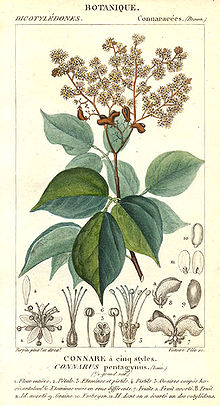Connaraceae
Матеріал з Вікіпедії — вільної енциклопедії.
| Connaraceae | |
|---|---|

| |
| Agelaea lamarckii[3] | |
| Біологічна класифікація | |
| Царство: | Рослини (Plantae) |
| Клада: | Судинні рослини (Tracheophyta) |
| Клада: | Покритонасінні (Angiosperms) |
| Клада: | Евдикоти (Eudicots) |
| Клада: | Розиди (Rosids) |
| Порядок: | Квасеницецвіті (Oxalidales) |
| Родина: | Connaraceae R.Br.[1][2] |
Connaraceae — пантропічна родина рослин, що складається з 19[4] родів і понад 180 видів[5] переважно вічнозелених дерев, деревних чагарників і альпіністів. Родина була вперше описана Робертом Брауном у 1816 році, і назва збереглася[1][2].
Connaraceae є тропічною родиною, найважливіші роди з якої Connarus (приблизно 80 видів) і Rourea (40–70 видів) мають пантропічне поширення[6]. Середовищем їхнього існування є, як правило, рівнинні тропічні ліси та савани.
Коннарові зазвичай є вічнозеленими деревами, кущами чи виткими рослинами. Connarus представлений видами всіх трьох життєвих форм[6], тоді як види Rourea є виткими рослинами. Листки у них перисті, трійчасті або рідше цілісні, чергові, без прилистків і з пульвином біля основи листкової ніжки. Connarus guianensis має економічне значення завдяки своїй декоративній деревині[7].
- Agelaea
- Burttia
- Cnestidium
- Cnestis
- Connarus
- Ellipanthus
- Hemandradenia
- Jaundea
- Jollydora
- Manotes
- Paxia
- Pseudoconnarus
- Rourea
- Roureopsis
- Santalodes
- Santaloides
- Spiropetalum
- Taeniochlaena
- Vismianthus
Відбиток скам'янілої листівки, описаний як Rourea miocaudata з Індії, демонструє велику схожість із листочками наявної Rourea caudata, її було зареєстровано в нижній частині відкладень Siwalik (формація Дафла, середній–верхній міоцен) району Пінджолі в районі Західний Каменг, Аруначал Прадеш[8]. Промінералізована деревина стебла з характерною анатомією ліани була описана з викопними фруктами з місцевості в формації Кукарача нижнього міоцену (19 млн років тому), де формація відкрита розрізом Кулебра Панамського каналу. Анатомія цієї викопної деревини відповідає роду Rourea. Викопні рештки Connaraceae нечисленні, достовірні випадки вказують на те, що сімейство виникло ще в пізньому крейда-палеоцені та було широко поширене на початку міоцену[9].
- ↑ а б "Connaraceae". Australian Plant Name Index, IBIS database. Centre for Plant Biodiversity Research, Australian Government.
- ↑ а б Brown, R. (1818). Appendix No. V: Observations, systematical and geographical, on Professor Christian Smith's collection of plants from the vicinity of the River Congo. У Tuckey, J.H. (ред.). Narrative of an expedition to explore the river Zaire, usually called the Congo, in South Africa, in 1816. с. 431.
- ↑ illustration circa 1820 from Pierre Jean François Turpin (1775-1840) - Dictionnaire des sciences naturelles. Planches … Botanique classée d’après la méthode naturelle de M. Antoine-Laurent vol. 5 plate 267
- ↑ Connaraceae (англ.). The Plant List. Version 1.1. 2013. Процитовано 18 вересня 2016.
- ↑ Christenhusz, M. J. M.; Byng, J. W. (2016). The number of known plants species in the world and its annual increase. Phytotaxa. Magnolia Press. 261 (3): 201—217. doi:10.11646/phytotaxa.261.3.1.
- ↑ а б Heywood, V.H.; Brummitt, R.K.; Culham, A.; Seberg, O. (2007). Flowering plant families of the world. Firefly Books. ISBN 9781554072064.
- ↑ Encyclopedia Britannica: Connaraceae plant family. Процитовано 24 квітня 2018.
- ↑ First fossil evidence of Connaraceae R. Br. from Indian Cenozoic and its phytogeographical significance by MAHASIN ALI KHAN and SUBIR BERA - Journal of Earth System Science - July 2016, Volume 125, Issue 5, pp 1079–1087
- ↑ A liana from the lower Miocene of Panama and the fossil record of Connaraceae by Nathan A Jud and Chris W Nelson - American Journal of Botany 2017 May 12;104(5):685-693.
Text is available under the CC BY-SA 4.0 license; additional terms may apply.
Images, videos and audio are available under their respective licenses.
